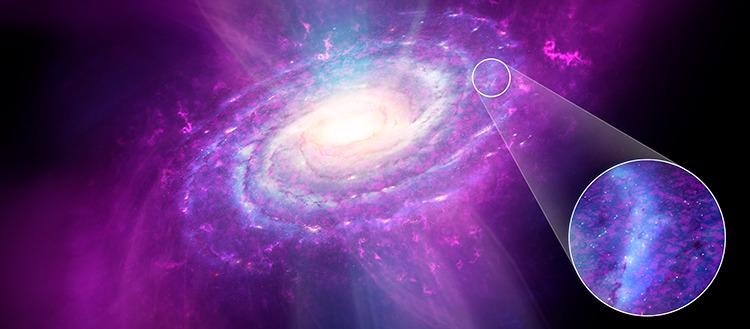Reviewed by Alex SmithSep 9 2021
Astronomers are analyzing the gases and metals that constitute an important region of the Milky Way galaxy to learn more about its history and evolution.
 Artist impression: Clouds and streams of cosmic pristine gas (magenta) accrete onto the Milky Way, but this gas does not efficiently mix in the Galactic disk, as highlighted for the Solar neighborhood (zoom-in). Image Credit: Dr Mark A. Garlick.
Artist impression: Clouds and streams of cosmic pristine gas (magenta) accrete onto the Milky Way, but this gas does not efficiently mix in the Galactic disk, as highlighted for the Solar neighborhood (zoom-in). Image Credit: Dr Mark A. Garlick.
There are three main notable elements: the initial gas emerging from outside the galaxy, the gas between the stars inside the galaxy which is enriched with chemical elements, and the dust produced by the condensation of the metals present in this gas.
So far, theoretical methods predicted that these three elements were mixed homogeneously throughout the Milky Way and attained at a stage of chemical enrichment similar to the atmosphere of the Sun, known as solar metallicity.
A team of astronomers from the University of Geneva explained that these gases are not mixed as expected before, which influences the present learning of the evolution of galaxies. As a result, the simulation of the evolution of the Milky Way galaxy needs to be modified.
The study results were published in the journal Nature.
Galaxies are formed with a collection of stars and by the condensation of gas of the intergalactic medium composed of majorly hydrogen and a small composition of helium. This gas does not hold metals similar to the gas in galaxies. In astronomy, all chemical elements heavier than helium are collectively called “metals,” even when they are atoms in gaseous form.
According to Annalisa De Cia, the study first author and professor in the department of astronomy at the University of Geneva, “Galaxies are fuelled by ‘virgin’ gas that falls in from the outside, which rejuvenates them and allows new stars to form.”
Meanwhile, stars burn hydrogen found in them throughout their life and produce another element through nucleosynthesis. A star explodes at the end of its lifetime and releases the metals it has produced, like zinc, iron, silicon and carbon. These are then fueled into the gas of the galaxy. These atoms then condense into the colder and denser regions of the galaxy as dust.
Initially, when the Milky Way was formed, more than 10 billion years ago, it had no metals. Then the stars gradually enriched the environment with the metals they produced.
Annalisa De Cia, Study First Author, and Professor, Department of Astronomy, University of Geneva
When the volume of metals in the gas attains a level similar to that of the sun, it is regarded as solar metallicity.
A Not so Homogeneous Environment
The environment that forms the Milky Way combines the metals produced by the stars, the dust particles that have formed from these metals, as well as gases regularly entering inside from other galaxies.
Until now, theoretical models considered that these three elements were homogeneously mixed and reached the Solar composition everywhere in our galaxy, with a slight increase in metallicity in the centre, where the stars are more numerous. We wanted to observe this in detail using an Ultraviolet spectrograph on the Hubble Space Telescope.
Patrick Petitjean, Researcher, Institut d’Astrophysique de Paris, Sorbonne University
Spectroscopy enables light from stars to be separated in its individual frequencies and colors, somewhat similar to a prism or a rainbow. Astronomers are specifically concerned about absorption lines in this decomposed light.
“When we observe a star, the metals that make up the gas between the star and ourselves absorb a very small part of the light in a characteristic way, at a specific frequency, which allows us not only to identify their presence, but also to say which metal it is, and how abundant it is,” added Petitjean.
A New Method Developed to Observe the Total Metallicity
The scientists using the Hubble and the Very Large Telescope (VLT) in Chile to observe the atmosphere of 25 stars for 25 hours. The challenge here is that the dust cannot be counted using the spectrographs, even though it is made of metals. Therefore, the team developed a new observation technique.
Annalisa De Cia stated, “It involves taking into account the total composition of the gas and dust by simultaneously observing several elements such as iron, zinc, titanium, silicon and oxygen. Then we can trace the quantity of metals present in the dust and add it to that already quantified by the previous observations to get the total.”
Credit goes to the dual observation technique as the astronomers identified that, apart from the Milky Way environment being homogeneous, few regions that were analyzed had only 10% of the solar metallicity.
This discovery plays a key role in the design of theoretical models on the formation and evolution of galaxies. From now on, we will have to refine the simulations by increasing the resolution, so that we can include these changes in metallicity at different locations in the Milky Way.
Jens-Kristian Krogager, Researcher, Department of Astronomy, University of Geneva
The outcomes have a strong influence on the study of the evolution of galaxies. Metals also play an important role in the formation of molecules, cosmic dust, stars and planets. It is now clear that new stars and planets could form from different compositions of gases.
Journal Reference:
Cia, A. D., et al. (2021) Large metallicity variations in the Galactic interstellar medium. Nature. doi.org/10.1038/s41586-021-03780-0.